“Preliminary Findings Toward an Architectural History of the Network,” New Geographies 07 (2015)
PDF is here.
note: during the editing process at the journal, a section of the text was deleted and, along with it, the New York City Post office designed by Alfred B. Mullett was misattributed to George B. Post. The missing text is included in blue.
As a set of technical protocols determined by the limitations of technologies, the network has received much critical attention since the Internet began to proliferate in the 1990s. By contrast, there has been little research on networks from an architectural perspective. The network as a material fact, as a geographic condition shaped by the constraints of the physical world and punctuated by buildings, remains to be written. Any such investigation would necessarily consider the network’s infancy; that is, its historical emergence in typological terms.
But how can we understand the data center as a building type? Can we even speak of a building type when centers encompass at once repurposed buildings, such as One Wilshire in Los Angeles, as well as purpose-built skyscrapers such as 60 Hudson Street or the AT&T Long Lines Building in New York, and warehouse-like, horizontal facilities in exurban areas like Google’s data center at The Dalles, Oregon, or the NYSE Euronext Liquidity Center in Mahwah, New Jersey? Data centers, it would seem, have radically different architectural manifestations and appear in remarkably different sorts of geographic conditions.
To study a building type, we must begin with both a definition and a historical genealogy. At its most essential, the data center is a structure dedicated specifically to the transmission of information. The specific nature of the communication media is unimportant to our analysis here; rather, the focus is on the processing of data. One could examine a number of different media that might lay
claim to originating the data center. We might start with a very old type—the library. Its rows of shelves have long carried information banks in the form of books. Networks, however, constituted only a minor aspect of libraries, as the circulation between one branch and another, or from main library to branch library, represents only a small part of a library system’s total circulation, with formalized interlibrary loans emerging only recently, at the tail end of the nineteenth century. The earliest building type that might confidently be identified as a data center is, instead, the post office, which developed in the United States in the mid-nineteenth century. Immediately, we are confronted by the link between data center and territory. More than any other country had done previously, the United States placed emphasis on the mail system throughout its political development.
From the onset, the Constitution invested Congress with the expressed power “to establish post offices and post roads.” Understanding the service as essential for building a sense of nationhood among the far-flung states and spreading information necessary for the operation of the republic, Congress enacted the Postal Act of 1792. Through the act, Congress took direct responsibility for the control of the mail and encouraged the circulation of information by discounted rates to newspapers. It rapidly expanded the network of postal routes and offices across the country: by 1828 there were 114,536 miles of post roads across the country, up from 1905 in 1791 (a year prior to the Postal Act). The postal system soon became the largest branch of the federal government, with out- posts in every town in the country. Historian Richard John writes, “it would hardly be an exaggeration to suggest that for the vast majority of Americans the postal system was the central government.” (01) By 1831, postal service employees made up just over three-quarters of all federal civilian employees. That same year Alexis de Tocqueville observed that the typical frontiersman, although he might appear rude and ignorant, is actually “a highly civilized being, who consents, for a time, to inhabit the backwoods, and who penetrates into the wilds of the New World with the Bible, an axe, and a file of newspapers.” That file of newspapers was not brought from the city; rather, it came by mail. De Tocqueville continued, “It is difficult to imagine the incredible rapidity with which public opinion circulates in the midst of these deserts.” (02) Another writer of the time, impressed by the ease of communication made possible by the US postal system, stated, “Time and distance are annihilated.” (03)
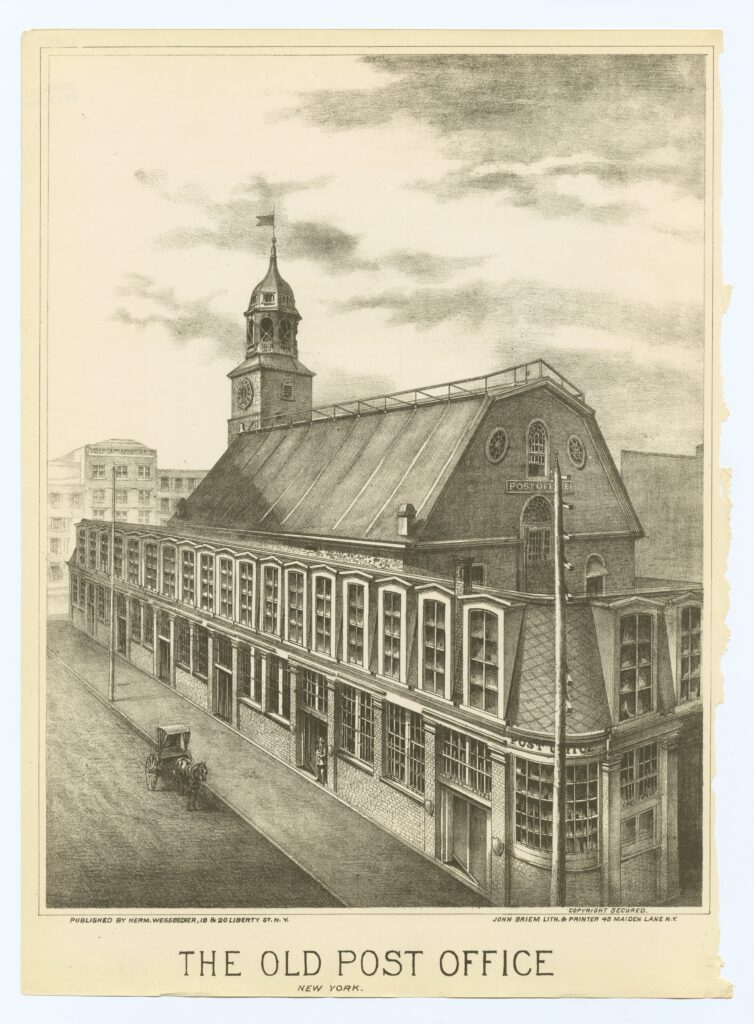
The Old Post Office in the Dutch Reformed Church, New York.
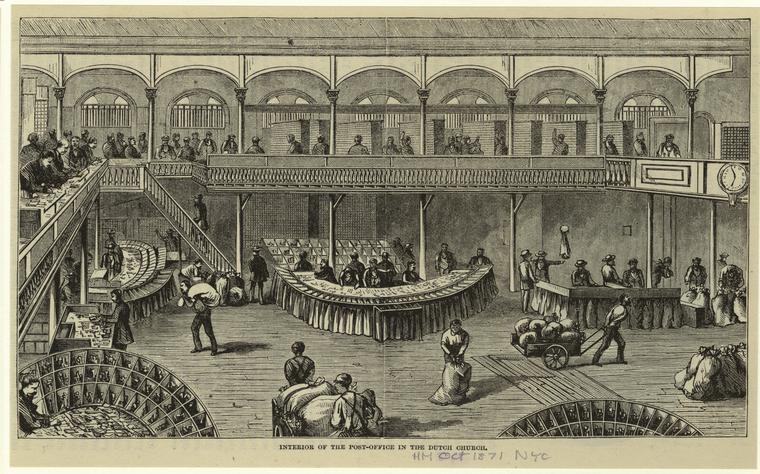
Sorting Room in the Interior of the Old Post Office in the Dutch Reformed Church, New York, 1871.
During the first half-century of mail service, post offices had no specific form. In small towns they could be located within stores or even the home of a postmaster. In cities, post offices rented existing buildings in business centers. Historian David Henkin describes the vicissitudes of the New York office, the busiest in the nation, writing that it “occupied a two-story wooden house in Lower Manhattan in 1825 that was known as the Academy Building. Two years later, the post office moved to the merchants’ exchange, then to the rotunda near City Hall, and from there in 1845 to a Dutch Reformed Church, where it remained until after the Civil War.” (04) This itinerant condition was intentional: for the network to take visible architectural form would have been risky in an era of widespread anti-Federalist sentiment. The only exception to this was the General Post Office Building in Washington, DC, constructed in 1836 and housing not only the District of Columbia’s post office but also the quarters of the postmaster general and the central administration. One observer called it “perhaps the most beautiful edifice at the capital.” (05) But outside the capital, the appearance of the post office as more than an infrastructural element would have risked disrupting the tenuous territorial balance between the federal system and local autonomy.
In 1800 the postal service implemented a hub-and-spoke system for its network, replacing the earlier point-to-point system with the delivery of mail sacks via stagecoach to distributing post offices in key logistical locations. By 1828 there were some forty-eight distributing offices acting as data processing facilities: a letter sent from one location to another would be taken to the nearest distributing office and sorted into the appropriate category for delivery by stagecoach or boat to the distributing office nearest its destination, where it would again be sorted into packets. In a footnote, John observes that the creation of this network was a revolutionary shift in communication since, for the first time, “postal officers routinely distinguished between the conveyance of the portmanteau that protected the mail and the transmission of the mail itself.” (06) Put another way, a level of abstraction between the message being carried and the way it is being carried had entered the system.
The geographical mandate of the federal postal system—to serve more than 1.5 million square miles, encompassing the original colonies, Northwest Territory, and Louisiana Purchase—necessitated the growth of the distributing offices. Thus, while some of the distributing offices doubled as main post offices in major cities (in 1851, fourteen of the fifteen largest cities in the United States had distributing offices), others were located in strategic exurban locations, such as Cumberland Gap, Kentucky; Napoleon, Arkansas; and Vicksburg, Mississippi. (07)
If the distributing office served as a hub in this network, post roads formed the spokes. Proponents of the federal construction of roads understood the Constitution’s mandate to “establish … post roads” as authorizing it to construct a nationwide public transportation network; stagecoach routes that operated on it were private, profiting off of postal service contracts. (08) But given continued resistance to the expansion of the federal government, coupled with the government’s lack of capital, post roads (and later, railroads) were typically funded by private investors, who would derive their profits from the postal contracts or tolls until (at least in the case of the roads) their grant of monopoly status ended and the roads became public. (09)
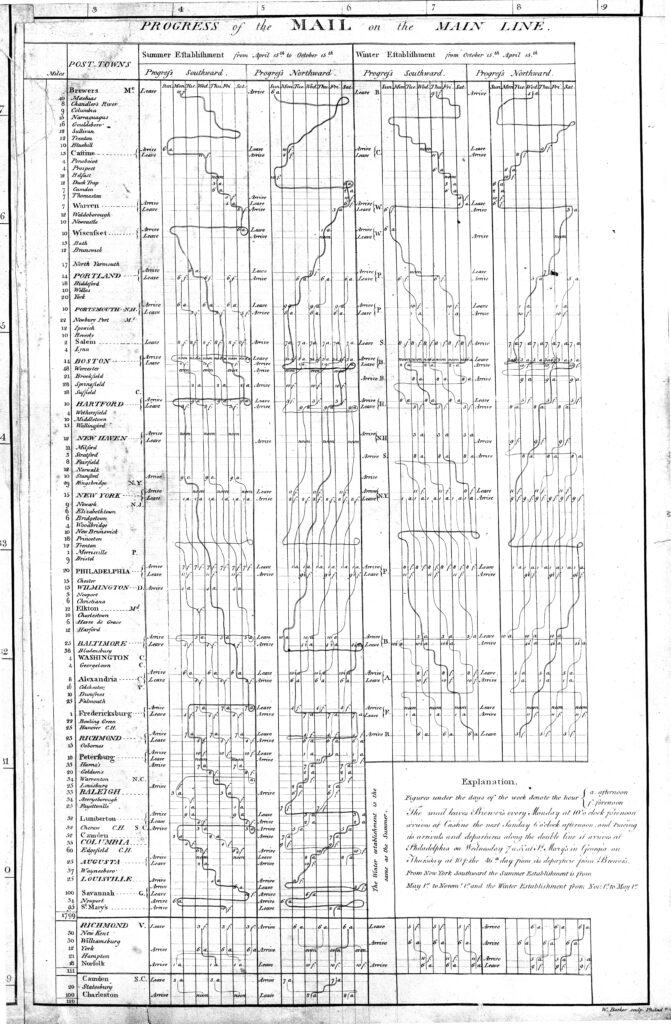
First Assistant Postmaster, Abraham Bradley Jr., Progress of the Mail on the Main Line, detail, from A Map Of The United States Exhibiting Post Roads & Distances, 1796.
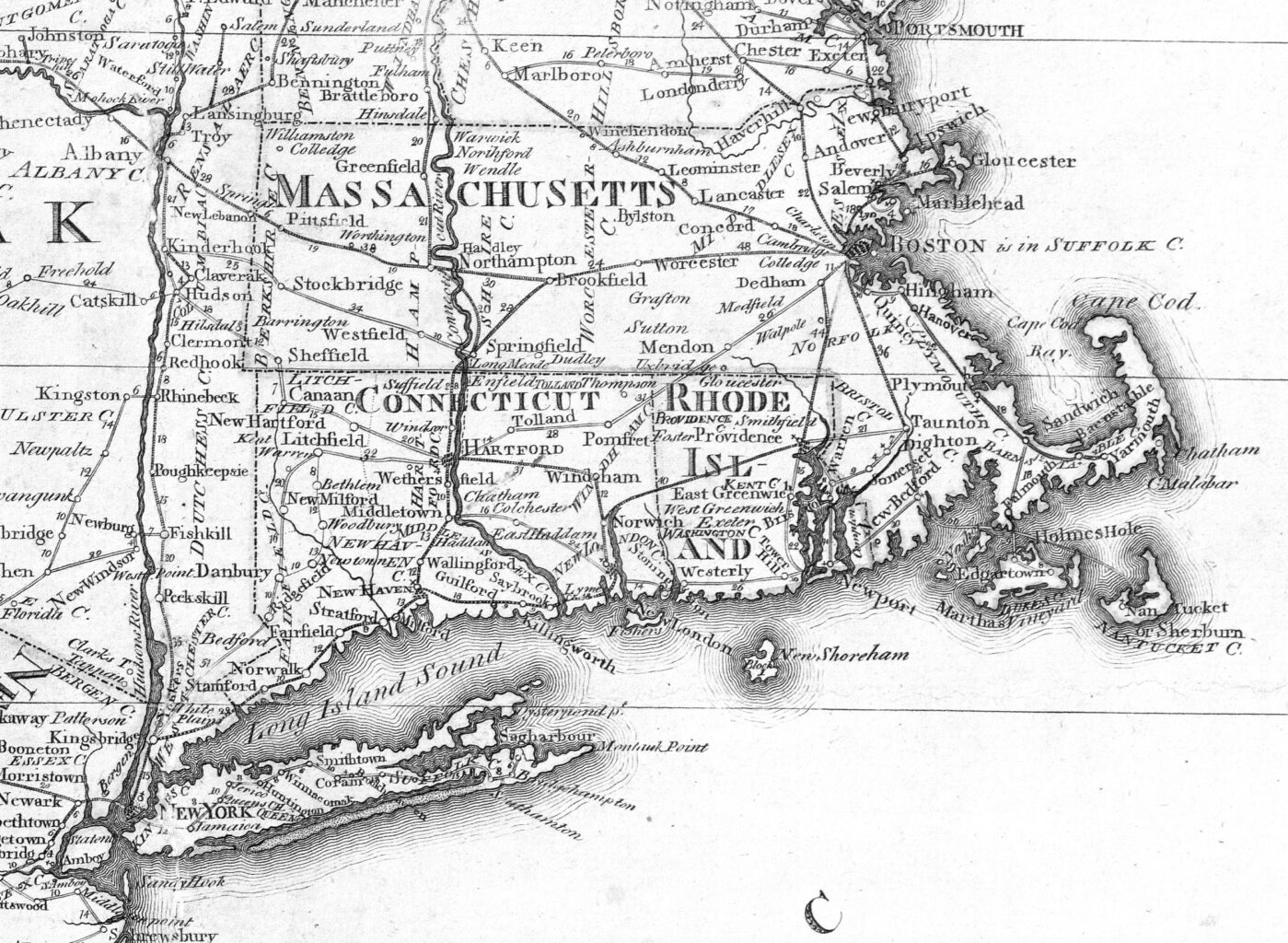
First Assistant Postmaster, Abraham Bradley Jr., Postal Routes Between New York City and Boston, detail, from A Map Of The United States Exhibiting Post Roads & Distances, 1796.
Throughout the nineteenth century, customs tariffs made up a majority of the federal government’s revenue. The employment of architects from the US Treasury’s Office of the Supervising Architect (founded in 1852) to construct new customs houses underscores the revenue produced by this branch of government and echoes the earlier status of the customs house in England. To save time and money, the architecture of customs houses and post offices was standardized: identical structures were often constructed in multiple locations. Thus, a building in Cleveland, Ohio, had a near-identical twin in Wheeling, Virginia (which became West Virginia in 1861 in that same building, now West Virginia Independence Hall). Still, in a country that had not yet been accustomed to architectural production by the government, and had seen virtually no construction at a federal level outside of the US capital, these works were considered so worth recording that the Treasury Department sent out lithographed copies of the design to depository libraries, the Smithsonian, and other institutions. (10)
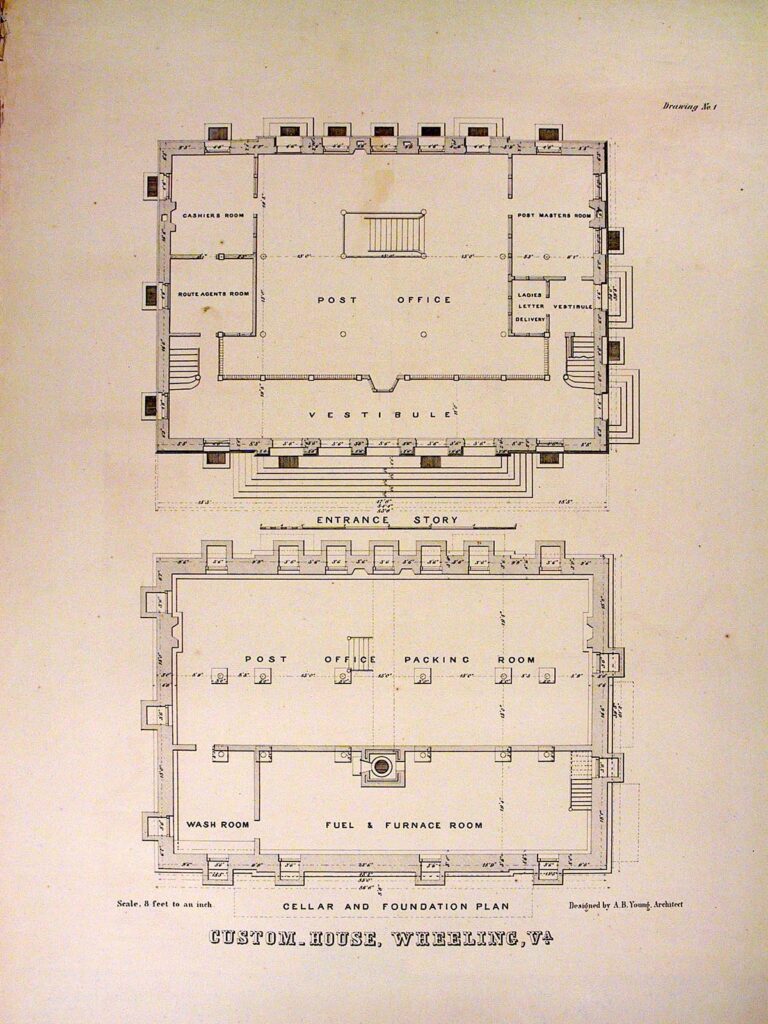
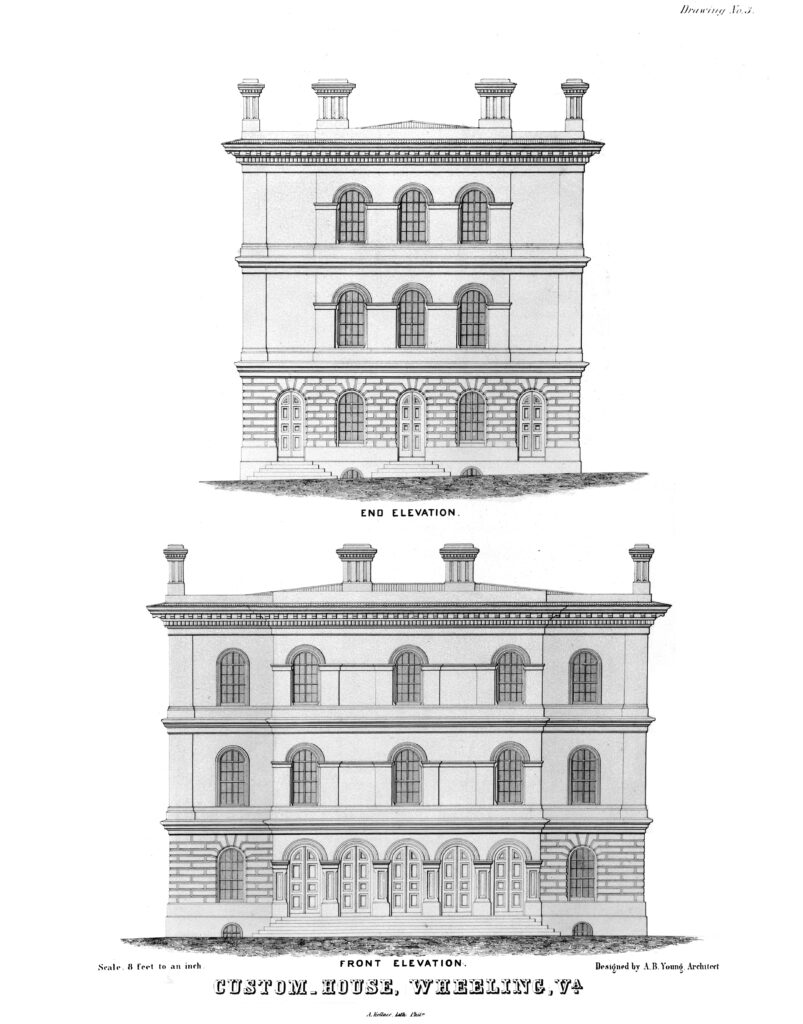
Ammi B. Young, US Treasury’s Office of the Supervising Architect, Customs House, Wheeling, VA, 1859
Changes in the postal system led to a greater need for a public face for dedicated post offices in cities. In 1845 Congress reformed the pricing of the postal system to radically lower the price of postage required on letters written by individuals. This significantly boosted the volume of personal and business correspondence. As the postal service did not offer home delivery until the 1860s, individuals were forced to visit post offices during the course of the business day to post and retrieve letters. Post office lobbies became clamorous spaces of social mixing and, given that sending large amounts of currency through the mail was the most common means of transmitting money over a distance, often dangerous spaces as well, frequented by pickpockets and con artists looking for an easy mark.
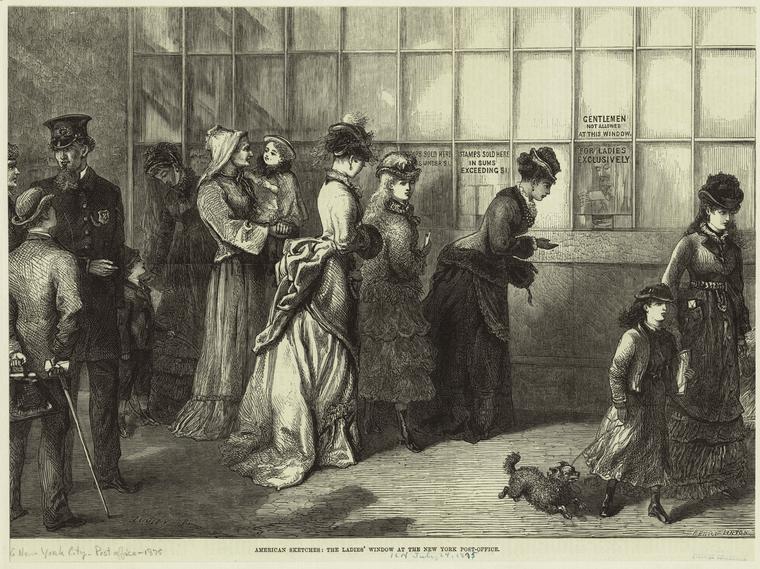
“The Ladies’ Window at the (old) New York Post Office,” 1875
The mail service largely fostered intercity communications until 1863, when Congress (following an earlier British innovation) enacted home delivery in the nation’s fifty largest cities. Home delivery served a number of social purposes: it responded to concerns about the danger that the heavily male space of the post office posed to women, and made the receipt of letters from Union soldiers during the Civil War a private matter. But for postal reformers, its main purpose was to make intracity mail viable. (11) With the increase in letter writing due to lower postage costs and the advent of urban home delivery, new pressure was placed on the postal network, even as the role of the post office itself changed. Although still necessary for some transactions, post offices became hubs in the system, dedicated to processing, rather than end nodes. (12)
The most important post office outside of the headquarters in Washington was New York’s and with the massive flow of mail through the old post office, the small Dutch Reformed Church was overwhelmed. A site for a new post office, in which the federal courthouse would also be located, was obtained across from City Hall and, under the influence of the American Institute of Architects, a competition for the design was held, an unprecedented compromise for the Supervising Architects’ Office and one that would not stand for long. The results met with the disapproval of the Office and Alfred B. Mullett, the Supervising Architect himself, produced a design in the fashionable French Empire style which itself proved controversial but nevertheless secured itself a highly visible role in the urban fabric. (12A)
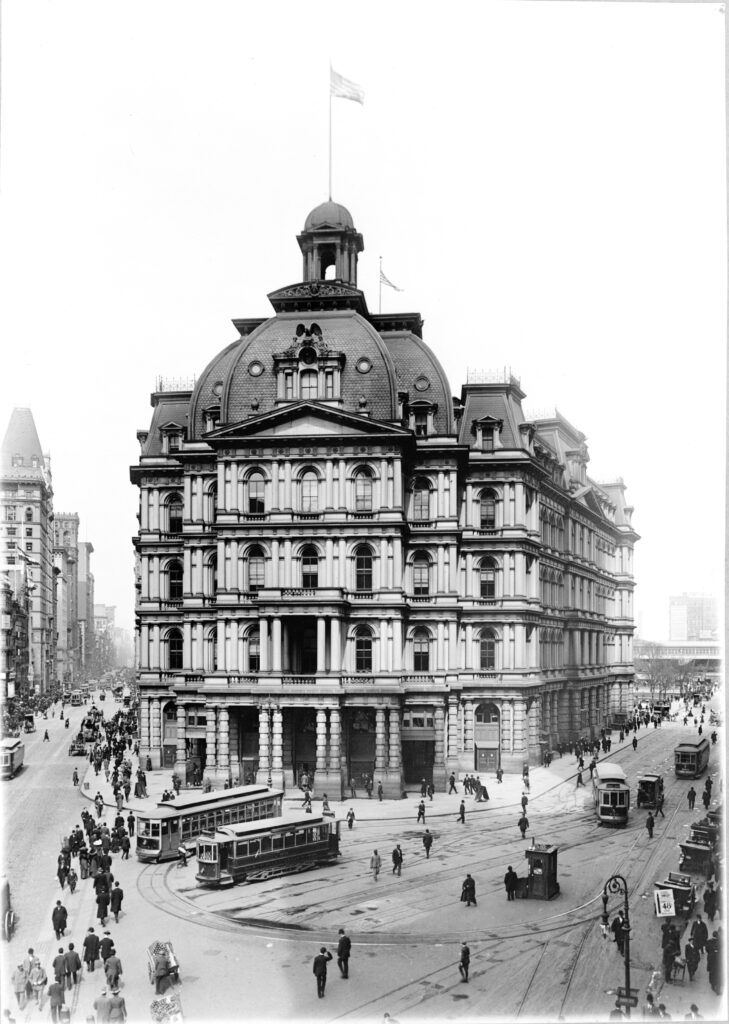
Alfred B. Mullett, City Hall Post Office, New York City, 1869-1880, view c. 1910.
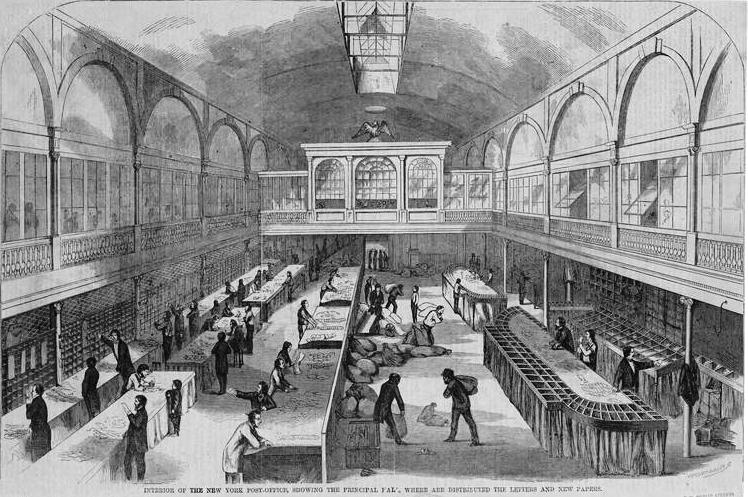
Sorting Room, City Hall Post Office, New York City, after 1880
By this point, however, the postal service had encountered its first competitor—the telegraph. Optical telegraphs had been developed in France in the 1790s and were employed in the northeastern United States in the early nineteenth century for ship-to-shore communication. Optical telegraphs had severe limitations: it could only function in daylight and good weather. Still, the potential of telecommunications to bind together territory on a global scale more rapidly and thoroughly than the postal service ever could was clear. In 1800 polymath and architect of the US Capitol building, William Thornton, in calling for the creation of a United North and South Columbia to rule the hemisphere, wrote, “Telegraphs, when perfected, will convey from the remotest bounds of this vast Empire, any communication to the supreme government in twenty-four hours, with ease.” (13)
Such links finally became possible when, on May 24, 1844, Samuel F. B. Morse transmitted the words “What hath God wrought?” over an electric telegraph line stretching from Baltimore to Washington, DC. Morse had hoped his invention would be adopted by the government and integrated into the postal service, a reasonable idea given that in 1837 the Secretary of the Treasury had requested proposals for a “system of telegraphs” across the country. But increased opposition to federal spending undid his hopes. After an initial burst of public excitement, private interest waned as well, and the telegraph came to be considered more of a novelty—a feeling inspired in part by the carnival-like atmosphere around demonstrations of it being used to play chess or checkers. Even as more far-sighted investors began building out telegraph networks, the system became plagued by problems. In comparison to the mail, telegraph service was limited to routes connecting major cities: by 1851 the telegraph had only as many miles as the post office had in 1801. Telegraph carriers generally had little interest in routing a message from a competing network through their own lines. Bad weather interfered with transmission and fallen trees repeatedly knocked out service altogether. Moreover, a telegraph was far more expensive to send: fifty cents for the transmission of a mere ten words from Washington, DC, to New York, and $2.20 from Washington, DC, to New Orleans, as opposed to just three cents for the delivery of a letter. (14)
Telegraphy consolidated in the 1860s. The first transcontinental telegraph line was completed in 1861, eight years ahead of the first transcontinental railroad; a huge influx of messages and government funding boosted telegraphy during the Civil War (1861–1865); and Cyrus Field’s development of the first successful transatlantic cable in 1866: all of these events helped both the industry and the network mature. At the same time, one company—Western Union, founded in 1851—had shrewdly overcome or absorbed all of its rivals to dominate the telegraph market. The result was the largest corporation in the country, exceeding any single railroad in size and small only in comparison to the postal service. (15)
The growth of telegraphy was also boosted by its alliance with the media; specifically a consortium of newspapers called the Associated Press (AP). In a country stretched across a continent, newspapers fulfilled an important role: businessmen came to rely on them for the timely news upon which they would gauge important decisions. Founded in 1846, the association of newspapers played a crucial role in strengthening this reliance by effectively consolidating news-gathering agencies and making what were once local or regional stories available to newspapers nationwide. The AP dictated the terms of the association, insisting that only its own wire dispatches could be printed in the newspapers that sub- scribed to its service. (16) As of 1867, Western Union dedicated the fourth floor of its general office in New York to the AP, offering the first example of a company collocating inside a carrier’s facility. (17)
Newspaper editors and publishers frequently voiced their opinion that both the AP and Western Union constituted monopolies, posing threats to the competition as well as to the freedom of the press. In this, telegraphy produced another first: until this time monopolies had only been produced by grants from the state. The concerns raised against Western Union prefigured twentieth- century concerns about AT&T. (18)
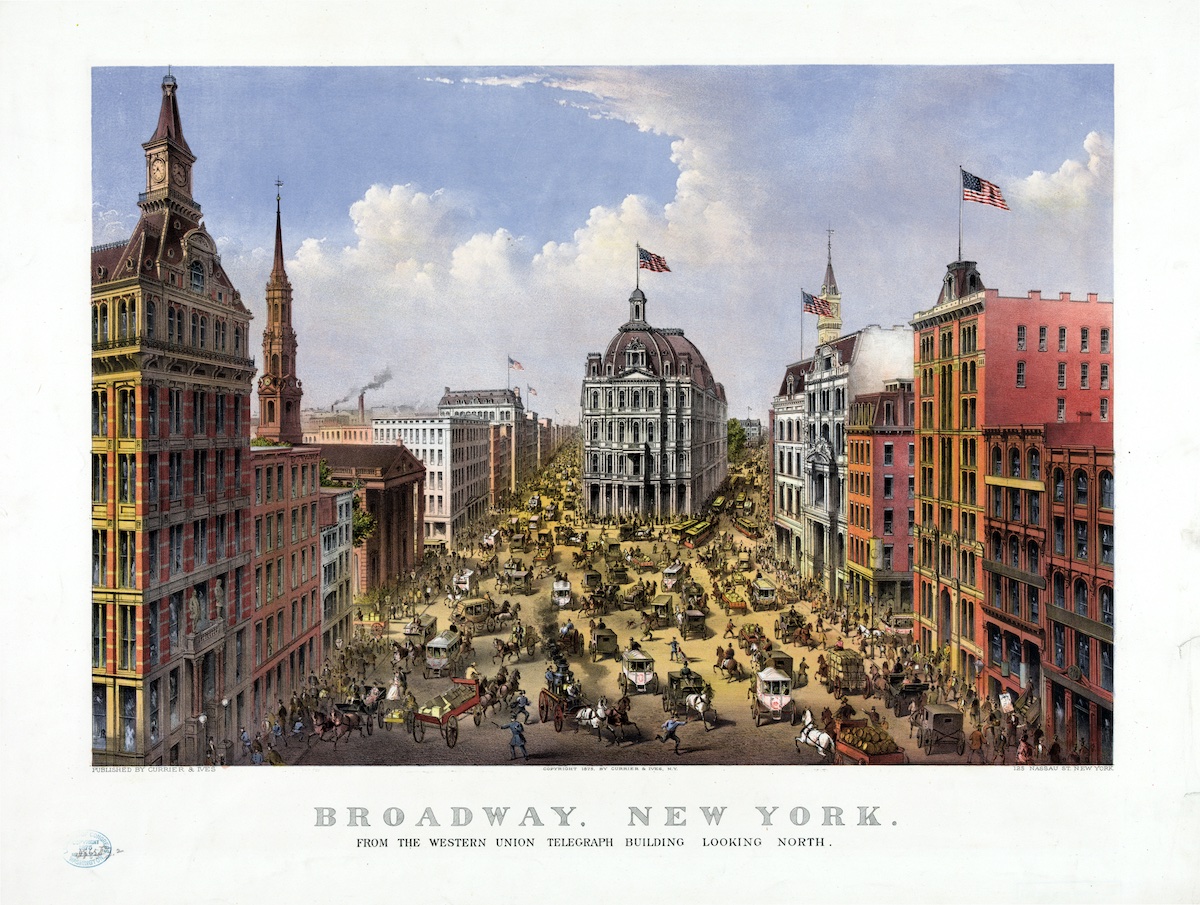
Above: Currier & Ives, Broadway, New York. From The Western Union Telegraph Building Looking North, 1875.
Western Union managed to defend itself against its critics (as did the AP) and, after initial tension subsided, it found new allies in the railroads, which used telegraphy to coordinate train travel; for example, the telegraph allowed a single track to be used by trains bound in both directions. In 1870, “Commodore” Cornelius Vanderbilt, who had made a fortune in shipping and rail, secretly acquired Western Union. The result was a symbiosis between rail and telegraph industries, as railroads allowed Western Union to outfit train stations with telegraph offices and to use their rights of way to erect telegraph poles. (19) In addition to the AP and the railroads, the major commodities exchanges also relied on the telegraph. Understanding the advantage on the market that even a minute of advance warning in the news could bring, agents sought to get their messages out first by any means possible, including bribing telegraph operators. (20)
More than any other enterprise to date, with the exception of the post office, Western Union faced the problem of administering and coordinated a large number of employees, dispersed among thousands of offices (7,672 in 1878). Compounding this effort was the vast amount of data the firm had to handle. In 1878, 93,127 messages were handled within the headquarters alone. (21) Although a recent study by historian Joshua Wolff suggests it was a plodding process of trial and error, Western Union eventually developed one of the first modern corporate organizational structures. (22) Reflecting this, the company built
a massive headquarters by George B. Post across from the Alfred B. Mullett–designed New York Post Office, beginning construction in 1872 and finishing in 1875. Not only was this a symbolic challenge to the rival postal service, the site also abutted Printing House Square, (now Park Row), home to a number of the city’s newspapers. (23) Like the Post Office across the way, inside the building was a blend of spaces, including an imposing public lobby and facilities for staff from telegraphy operators to managers, as well as batteries and dynamos for the telegraph equipment. The new Western Union Building—which, at ten stories, held the title of tallest building in the city for four months—was organized vertically; circulation was provided by elevators, a new invention of the time. The “receiving room,” where the public would come to send messages, was located on the ground floor, together with various support facilities such as cashiers’ offices. In another one of the earliest instances of collocation, related industries were allowed to rent rooms on the second and third floors, those floors serving as a buffer into which Western Union could expand.
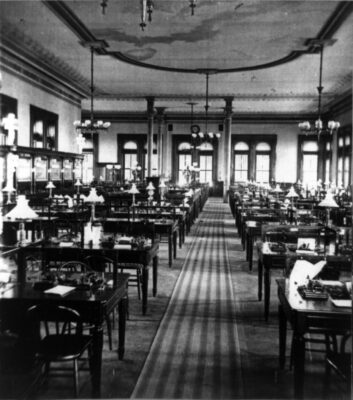
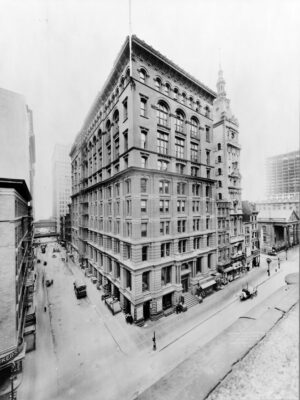
left: C. K. Bill, Western Union Telegraph Building, New York, General Operating Department, half of stereoscopic slide, 1875.
right: Irving Underhill, view of Western Union Telegraph Building showing carts and wagons on street, 1912.
The sixth floor of the Western Union building housed some six thousand batteries weighing about two hundred tons, which were used in transmitting messages. Telegraph wires were carried into the structure via wooden conduits on the facade, entering through a balcony at the seventh floor. Messages were inserted into pneumatic tubes in the receiving room on the ground floor and conveyed upward to the seventh-floor “operating room.” From there they were transmitted to (as well as received from) other offices, in code. Spanned by a roof truss, the 150-foot-long, sixty-foot-wide room had an open plan with no internal obstructions. It contained eighty- seven tables, each of which accommodated four operators. Above the operating room was a story occupied by the AP, and above that, a final story housing a kitchen and lunchroom. (24) Horizontal expansion across territory and verticality within the city were now firmly linked.
The topology of the Western Union network differed from that of the postal service. Here, major post roads were replaced by trunk lines from which sprang branch lines. Whereas letters were abstracted from their means of transmission through the process of sorting, telegraph messages had to travel over a single connection as much as possible. Information identifying the destination of a message would preface the message itself sent over a line. All offices on a line would receive all messages, and it was up to the destination office to respond with a notice that it had received a message. If possible, switchboards connected branch offices to the line; if this was not possible, messages had to be repeated by hand and sent on their way. Initially, only one telegraph message could be transmitted on a given line, but eventually technologies were developed to transmit messages in both directions and then to transmit two messages simultaneously in both directions. (25)
With the Western Union building adding the skyscraper to the previous two models—the rented post office and the horizontal postal sorting center—the third and final manifestation of the data center was put in place together with two network topologies, based on decentralized models. In contrast, the telephone system would initially take a step back, focusing on short distance, intracity communication, dominated by exchanges serving neighborhoods, with central offices located downtown only slowly becoming integrated in a long-distance network.
Even as they annihilated time and space, communication networks have been dependent upon them from their inception. Our own networks and data centers, located according to a complex calculus of the availability of power grids, security, latency, legal rights-of-way and even topography, are little different. These constructions are both architectural and territorial, tied to both urban and planetary scales. Designing the networks of our time demands that we consider such scalar qualities as well.
- Richard R. John, Spreading the News: The American Postal System from Franklin to Morse (Cambridge, MA: Harvard University Press, 1995), 3–4.
- Alexis de Tocqueville, Democracy in America, trans. Henry Reeve (New York: Colonial Press, 1899), 322–23.
- John, Spreading the News, 10. The original words, “Ye Gods! annihilate but space and time, And make two lovers happy,” so often bent to apply to communications and capital are Alexander Pope’s.
- David M. Henkin, The Postal Age: The Emergence of Modern Communications in Nineteenth-Century America (Chicago: University of Chicago Press, 2006), 65.
- Eli Bowen, The United States Post-Office Guide (New York: D. Appleton, 1851), 15. No matter what service, the federal government would typically rent existing buildings for its own purposes when outside of the District. Antoinette J. Lee, Architects to the Nation: The Rise and Decline of the Supervising Architect’s Office (New York: Oxford University Press, 2000).
- John, Spreading the News, 304.
- Bowen, The United States Post-OfficeGuide, 34.
- Daniel P. Carpenter, The Forging of Bureaucratic Autonomy: Reputations, Networks, and Policy Innovation
in Executive Agencies, 1862–1928 (Princeton, NJ: Princeton University Press, 2001), 69; and Theodore Sky, The National Road and the Difficult Path to Sustainable National Investment (Newark: University of Delaware Press, 2011). - John B. Miller, Case Studies in Infrastructure Delivery (Boston: Kluwer Academic Publishers, 2000), 120.
- Lee, Architects to the Nation, 60–61.
- Ibid., 82–83.
- Ibid., 84.
12A. Robert A. M. Stern, Thomas Mellins, and David Fishman, New York 1880: Architecture and Urbanism in the Gilded Age (New York: Monacelli Press, 1999), 133-38. - William Thornton, “Thornton’s Outlines of a Constitution for United North and South Columbia,” Hispanic American Historical Review 12, no. 2 (May 1932).
- Joshua D. Wolff, Western Union and the Creation of the American Corporate Order, 1845–1893 (Cambridge: Cambridge University Press, 2013), 16–24. On Morse’s attempts to secure congressional sponsorship of the telegraph network, see Richard R. John, Network Nation: Inventing American Telecommunications (Cambridge, MA: Belknap Press, 2010). The statistic about post road mileage appears in Dow, “The Progress and Present Condition of the General Post Office,” 203.
- John, Network Nation.
- Wolff, Western Union, 122.
- “The General Telegraph Office of Western Union in New York City,” Telegrapher 3, no. 56 (July 15, 1867): 1.
- Wolff, Western Union, 2, 53, and 116.
- Ibid., 133–34, 204.
- Ibid., 204.
- Joseph J. Korom, The American Skyscraper, 1850–1940: A Celebration of Height (New York: Brenden Books, 2008), 72–73.
- Wolff, Western Union, 264.
- Robert A. M. Stern, Thomas Mellins, and David Fishman, New York 1880: Architecture and Urbanism in the Gilded Age (New York: Monacelli Press, 1999).
- Korom, American Skyscraper, 72–77; “The New Telegraphic Heart of America,” New-York Daily Tribune, February 1, 1875, 12; and “The Western Union Telegraph Building,” Manufacturer and Builder (December 1873): 280.
- For a detailed explanation of the operation of telegraph networks, see International Correspondence Schools, Elements of Telegraph Operating Systems (Scranton, PA: International Textbook Company, 1912). For their history, see Ken Beauchamp, History of Telegraphy (London: Institution of Electrical Engineers, 2001).